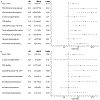Maternal and fetal outcomes in phaeochromocytoma and pregnancy: a multicentre retrospective cohort study and systematic review of literature
- PMID: 33248478
- PMCID: PMC7758862
- DOI: 10.1016/S2213-8587(20)30363-6
Maternal and fetal outcomes in phaeochromocytoma and pregnancy: a multicentre retrospective cohort study and systematic review of literature
Abstract
Background: Phaeochromocytoma or paraganglioma (collectively known as PPGL) in pregnant women can lead to severe complications and death due to associated catecholamine excess. We aimed to identify factors associated with maternal and fetal outcomes in women with PPGL during pregnancy.
Methods: We did a multicentre, retrospective study of patients with PPGL and pregnancy between Jan 1, 1980, and Dec 31, 2019, in the International Pheochromocytoma and Pregnancy Registry and a systematic review of studies published between Jan 1, 2005, and Dec 27, 2019 reporting on at least five cases. The inclusion criteria were pregnancy after 1980 and PPGL before or during pregnancy or within 12 months post partum. Eligible patients from the retrospective study and systematic review were included in the analysis. Outcomes of interest were maternal or fetal death and maternal severe cardiovascular complications of catecholamine excess. Potential variables associated with these outcomes were evaluated by logistic regression.
Findings: The systematic review identified seven studies (reporting on 63 pregnancies in 55 patients) that met the eligibility criteria and were of adequate quality. A further 197 pregnancies in 186 patients were identified in the International Pheochromocytoma and Pregnancy Registry. After excluding 11 pregnancies due to potential overlap, the final cohort included 249 pregnancies in 232 patients with PPGL. The diagnosis of PPGL was made before pregnancy in 37 (15%) pregnancies, during pregnancy in 134 (54%), and after delivery in 78 (31%). Of 144 patients evaluated for genetic predisposition for phaeochromocytoma, 95 (66%) were positive. Unrecognised PPGL during pregnancy (odds ratio 27·0; 95% CI 3·5-3473·1), abdominal or pelvic tumour location (11·3; 1·5-1440·5), and catecholamine excess at least ten-times the upper limit of the normal range (4·7; 1·8-13·8) were associated with adverse outcomes. For patients diagnosed during pregnancy, α-adrenergic blockade therapy was associated with fewer adverse outcomes (3·6; 1·1-13·2 for no α-adrenergic blockade vs α-adrenergic blockade), whereas surgery during pregnancy was not associated with better outcomes (0·9; 0·3-3·9 for no surgery vs surgery).
Interpretation: Unrecognised and untreated PPGL was associated with a substantially higher risk of either maternal or fetal complications. Appropriate case detection and counselling for premenopausal women at risk for PPGL could prevent adverse pregnancy-related outcomes.
Funding: US National Institutes of Health.
Copyright © 2020 Elsevier Ltd. All rights reserved.
Conflict of interest statement
Declaration of Interests
Dr. Bancos reports advisory board participation with Corcept, CinCor, and HRA Pharma outside the submitted work. Dr. Vaidya reports consulting for Corcept, HRA Pharma, and CatalysPacific, and research grants from National Institutes of Health and Ventus Charitable Foundation, all unrelated to the submitted work
Figures


Comment in
-
Phaeochromocytoma and pregnancy: looking towards better outcomes, less fear, and valuable recommendations.Lancet Diabetes Endocrinol. 2021 Jan;9(1):2-3. doi: 10.1016/S2213-8587(20)30371-5. Epub 2020 Nov 26. Lancet Diabetes Endocrinol. 2021. PMID: 33248479 No abstract available.
References
-
- Neumann HPH, Young WF Jr., Eng C. Pheochromocytoma and Paraganglioma. N Engl J Med. 2019;381(6):552–65. - PubMed
-
- Neumann HP, Young WF Jr., Krauss T, Bayley JP, Schiavi F, Opocher G, et al. 65 YEARS OF THE DOUBLE HELIX: Genetics informs precision practice in the diagnosis and management of pheochromocytoma. Endocr Relat Cancer. 2018;25(8):T201–T19. - PubMed
-
- Gruber LM, Hartman RP, Thompson GB, McKenzie TJ, Lyden ML, Dy BM, et al. Pheochromocytoma Characteristics and Behavior Differ Depending on Method of Discovery. J Clin Endocrinol Metab. 2019;104(5):1386–93. - PubMed
-
- Donatini G, Kraimps JL, Caillard C, Mirallie E, Pierre F, De Calan L, et al. Pheochromocytoma diagnosed during pregnancy: lessons learned from a series of ten patients. Surg Endosc. 2018;32(9):3890–900. - PubMed
Publication types
MeSH terms
Grants and funding
LinkOut - more resources
Full Text Sources
Other Literature Sources
Medical
Research Materials
Miscellaneous

